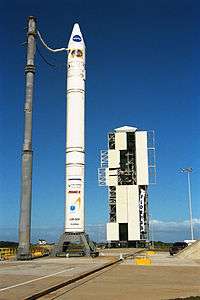Spaceport Florida Launch Complex 46
|
An Athena II at LC-46 prior to the launch of Lunar Prospector. | |||||||||||
| Launch site |
CCAFS (1987-1997) Spaceport Florida (1997—) | ||||||||||
|---|---|---|---|---|---|---|---|---|---|---|---|
| Location | 28°27′30″N 80°31′42″W / 28.45833°N 80.52833°WCoordinates: 28°27′30″N 80°31′42″W / 28.45833°N 80.52833°W | ||||||||||
| Short name | LC-46 | ||||||||||
| Operator |
US Air Force Space Florida | ||||||||||
| Launch pad(s) | One | ||||||||||
| |||||||||||
Space Launch Complex 46 (SLC-46) is a launch complex at Cape Canaveral Air Force Station operated under license by Space Florida for Athena rocket launches.
History
Construction
During the construction of SLC-46, a nearby sounding rocket complex, LC-43 was demolished. Its operations were transferred to SLC-47.
Trident
SLC-46 was originally used for tests of the Trident II missile between 1987 and 1989. Following the completion of the Trident's land-based tests, the complex was deactivated.
Space Florida
In 1997, Space Florida began operations at the site, and was opened for commercial space operations. Lockheed Martin launched an Athena II and an Athena I from the pad in 1998 and 1999 respectively. The Athena II, launched January 7, 1998, carried the Lunar Prospector spacecraft which orbited the Moon. On January 27, 1999, the Athena I lifted off with Taiwan's first satellite, ROCSAT-1, carrying experimental communications, ocean imagery, and ionospheric studies instruments.
In March 2010, the USAF 45th Space Wing issued Real Property Licenses to Space Florida for Launch Complexes 36 and 46 at Cape Canaveral Air Force Station.[1][2] On July 1, 2010, the Federal Aviation Administration approved a Launch Site Operator's License for commercial launches at Launch Complex 46.[3]
On September 24, 2010, the Economic Development Commission of Florida's Space Coast was awarded a $500,000 Defense Infrastructure Grant from the State of Florida to be used for critical communications upgrades at SLC-46.[4] In early 2014, Space Florida contracted with Alliant Techsystems (ATK) to begin phase three of the communications infrastructure refurbishment, with completion expected to take one year.[5]
As of February 2014, NASA plans to launch the Orion Multi Purpose Crew Vehicle Ascent Abort 2 test flight (AA‑2) from SLC-46 in 2018.[5]
In July 2015, the U.S. Air Force and Orbital ATK announced a Minotaur IV launched from SLC-46 would be used for the ORS-5 mission in 2017.[6]
References
- ↑ "Air Force licenses two launch complexes for commercial use". Patrick Air Force Base. March 12, 2010. Retrieved March 15, 2010.
- ↑ Lange, Tina (March 12, 2010). "Space Florida secures licenses for Launch Complexes 46 and 36". Space Florida. Retrieved March 15, 2010.
- ↑ Staff (July 9, 2010). "Space Florida receives FAA license for SLC-46". Space Florida. Retrieved July 9, 2010.
- ↑ "FL. Governor Crist Awards $500k Defense Infrastructure Grant for SLC-46". The Spacearium. October 4, 2010. Retrieved October 4, 2010.
- 1 2 Messier, Doug (February 11, 2014). "ATK to Upgrade Space Florida's Launch Complex 46". Parabolic Arc. Retrieved February 12, 2014.
- ↑ Clark, Stephen (July 9, 2015). "Minotaur rocket selected to launch military satellite in 2017". Spaceflight Now. Retrieved July 15, 2015.
